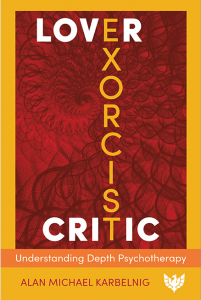
Alan Michael Karbelnig, PhD, a training and supervising psychoanalyst, providing psychoanalytically oriented individual and couples psychotherapy in Pasadena, California. Board certified in forensic psychology, he also offers psycho-legal services in the realms of administrative and employment law. He earned doctorates in Counseling Psychology from the University of Southern California (USC) and in Psychoanalysis from the New Center for Psychoanalysis (NCP). He founded Rose City Center (RCC) – a not for profit psychoanalytic clinic serving economically disadvantaged individuals throughout California. Dr Karbelnig writes extensively, and he also lectures locally, nationally, and internationally including, most recently, in Beijing, Shanghai, Shenzen, and Hong Kong, China, in Delhi and Ahmedabad, India, and in Tel Aviv, Israel.
Alan’s latest book, ‘Lover, Exorcist, Critic: Understanding Depth Psychotherapy’ dives deeply into the history of depth psychotherapy, examining the cultural and historical context from which it emerged, and explaining how it evolved into a more vitalising methodology
If you seek to understand depth psychotherapy in a more personal way, consider Lover, Exorcist, Critic. As you turn the pages, you’ll find unique insights, explanations – even confessions. My name is Alan Karbelnig, the author, and I’ve been practicing psychoanalytic psychotherapy for more than forty years. Over the few years it took me to write the book, I thought about the hundreds of psychoanalytic processes I’ve facilitated, how they transformed patients, and how they affected me. I remembered, with regret, some errors I made in practicing.
Lover, Exorcist, Critic describes the life stories of three patients – time travellers I call them – as they take the always-nonlinear, strange journey through depth psychotherapy work. I created fictional stories to illustrate patients’ experiences because, of course, identifying information must be hidden to protect actual patients’ privacy and confidentiality. However, these tales are based on patients I’ve personally seen. I also integrated what I’ve heard from supervising other practitioners. As a result, and I hope you’ll agree, these narrations of psychotherapist–patient encounters illustrate what depth psychotherapy really feels like. The patients’ experiences sound real; my reports obviously are. No books provide such visceral explanations of depth psychotherapy, and the dearth of literature fueled my writing. I consider my book most similar to the way Oliver Sacks wrote about his patients in his most famous book, The Man Who Mistook His Wife For A Hat.
Unfortunately, many people clearly understand cognitive behavioral therapy (CBT) or psychotropic medication. As far as the psychoanalytic approaches go, I fear, most still think of patients lying prone on couches while old white men sit behind them smoking cigars and taking notes. Such thinking is like comparing a Model T Ford with a Tesla. Psychoanalysis has undergone immense changes in the century since it was first introduced by Sigmund Freud. And yet, depth psychotherapy remains locked within its nineteenth-century image, poorly understood by those not intimately involved in its processes.
Lover, Exorcist, Critic dives deeply into the field’s history, examining the cultural and historical context from which it emerged, and explaining how it has since evolved into a more vitalized methodology. I expose the inner workings of depth psychotherapy through the perspective of three distinct social role analogies. As Lovers, psychoanalysts create a warm, accepting environment; as Exorcists, they receive, process, and deliver back projections; and, as Critics, they analyze, confront, and educate patients about self- and other-destructive patterns.
These methods come to life in the rich descriptions of how psychoanalytic processes progressed. Carlos, who suffered neglect and abuse during his childhood in East Los Angeles, struggled with the emotional intensity of depth psychotherapy and took months-long breaks when he felt too vulnerable. Gilda, a Greek-American woman sexually abused in her adolescence and traumatized by a physical attack in adulthood, grappled with periods of suicidal depression and episodic psychogenic fugue states. My feelings of helplessness mid-treatment of her led me to make some boundary crossings I’ve since regretted. The final patient, Penn, an orthopaedic surgeon struggling with anxiety and over-achievement which left him exhausted, demonstrates the benefit gained by a person undergoing depth psychotherapy, intermittently, for more than two decades.
during his childhood in East Los Angeles, struggled with the emotional intensity of depth psychotherapy and took months-long breaks when he felt too vulnerable. Gilda, a Greek-American woman sexually abused in her adolescence and traumatized by a physical attack in adulthood, grappled with periods of suicidal depression and episodic psychogenic fugue states. My feelings of helplessness mid-treatment of her led me to make some boundary crossings I’ve since regretted. The final patient, Penn, an orthopaedic surgeon struggling with anxiety and over-achievement which left him exhausted, demonstrates the benefit gained by a person undergoing depth psychotherapy, intermittently, for more than two decades.
These stories create the information I most wish to communicate: the unique, individualized way that psychoanalytic processes unfold. They are an effective, vibrant way for patients to reduce pain, to grow, and to live a more authentic life. Along these lines, I continue, to this day, to describe the goals of psychoanalytic processes to my patients like this:
We shall work together to reduce whatever struggles bring you in to see me. As we travel along that path, we will also discover information revealing the real, authentic you. These revelations will increase your sense of personal freedom and autonomy while, also, improving your capacity for finding and maintaining intimate relationships.
Alan Michael Karbelnig
Buy your copy of ‘Lover, Exorcist, Critic: Understanding Depth Psychotherapy’ now!

